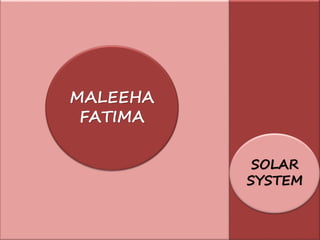
Solar system
- 2. INTRODUCTION The sun & the planets together make the solar system. Our solar system is elliptical (like an egg) in shape. Sun is the center & the biggest object in our solar system as it contains more than 99% of the solar system’s mass. Astronomers think that solar system is more than 4.5 billion years old. By MaleehaFatima
- 4. PLANETS The word “PLANET” comes from Greek word “PLANETES” which means “WANDERERS”. Planet is a term used for a body in orbit around the sun. By MaleehaFatima
- 5. Planets Mercury Venus Earth Mars Jupiter Saturn Uranus Neptune Inner Planets Outer Planets By MaleehaFatima
- 6. DWARF PLANETS According to International Astronomical Union (IAU): A dwarf planet is an object that orbits the sun, has enough mass to give it a nearly round shape, is not a satellite of another object and has not ‘cleared the neighbourhood’ of its own orbit. Pluto, Eris, Makemake & Ceres are examples of dwarf planets. By MaleehaFatima
- 7. Mercury is both hot & cold. It rotates very slowly. The side that faces the sun become so hot that it is hotter than inside of an oven. But, when that side moves away from the sun, it cools down until it is colder than a freezer. Which planet is hot like an oven & freezes like an ice? By MaleehaFatima
- 8. Venus is the hottest planet in the solar system. Its surface is obscured by dense yellow clouds, contain the sulphuric acid and rocky material. Its atmosphere has 97% carbon dioxide and its surface temperature is about 460 ˚C. It is visible from the Earth, & appears like a distant shiny star. Which is the hottest planet? By MaleehaFatima
- 9. 1 day of Venus is equal to 243 Earth days. Venus is unusual, as it rotates from East to West while all others planets rotate from West to East. It is equal to the size of Earth, therefore it is termed as “sister planet of Earth”. By MaleehaFatima
- 10. In astronomy mythology, earth’s Greek name was Gaea. Earth was the mother of the mountains, valleys, streams & all other land formations. She was married to Uranus. The Earth is the biggest of all the terrestrial planets. EARTH By MaleehaFatima
- 11. Mars looks red because it is covered with red rocks & red dust, the colour of rust. Its atmosphere consists mainly of carbon dioxide & water. In 1971, dust storms covered the whole planet. The surface completely disappeared from the view. Why is the Mars called “The red planet”? By MaleehaFatima
- 12. Which is the biggest planet? Jupiter is the biggest & most massive planet in the solar system. It is 11 times as wide as the Earth. It has a year of 11.86 Earth years. Jupiter is believed to consist mainly of solid, liquid & gaseous hydrogen. Jupiter’s day is about 9.26 hrs. It is covered in swirls of red & orange gases. It radiates energy, possibly because of nuclear reactions in its core or due to gravitational force of the planet. By MaleehaFatima
- 13. Which planet has rings? Saturn is surrounded by rings that shine brightly in the sun light. It orbits the sun in 29.46 years. Its total mass is about 95 times that of Earth. It has a cold nitrogen atmosphere with traces of methane & other gases. The most striking feature of Saturn is its ring system, composed of ice & rocks. The rings are made from millions lumps of ice. Some lumps are of the size of cubes. Others are as big as cars. By MaleehaFatima
- 14. Which planet rolls upright? In 1977, Uranus was discovered to have five rings. It spin as it moves around the sun. Although, this planet seems to be rolling around however it spins. By MaleehaFatima
- 15. Why does Neptune look so blue? Neptune is covered with bright blue clouds. Sometimes they appeared as just coloured lines & icy white clouds. Neptune year is 1648 times of that of Earth, its day is of 15.8 hrs. By MaleehaFatima
- 16. Which is the smallest planet? Pluto is the smallest planet. Its size is smaller than our moon. Pluto is very far away from the sun, it looks like a tiny speck (a very small spot) of light. By MaleehaFatima
- 17. Is there any giant made of gas? The planets Jupiter & Saturn are called gas giants. The Earth has a solid surface while Jupiter & Saturn don’t have solid surface. There is a thick layer of gas & then liquid. Therefore, a spacecraft or rocket cannot land on them. By MaleehaFatima
- 18. Why do Neptune & Pluto swap places? Most of the planets move around the sun in huge circles. Pluto circle is a bit squashed. This means that it is sometimes closer to the sun than the Neptune. After that it is the Neptune’s turn to be planet that is very far from the sun. By MaleehaFatima